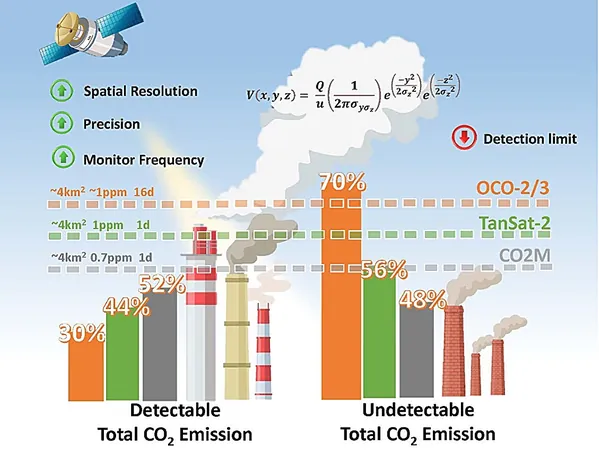
Shocking New Study Uncovers a 70% Underestimation of CO₂ Emissions from U.S. Power Plants!
2025-04-14
Author: Nur
New Research Raises Alarming Concerns
A groundbreaking study published in the Journal of Remote Sensing has revealed that existing satellite technology dramatically underreports carbon dioxide emissions from thermal power plants in the United States by a staggering 70%! This revelation comes from a team of scientists at the Aerospace Information Research Institute of the Chinese Academy of Sciences, and it signals major flaws in our current satellite monitoring systems.
What’s Wrong with Current Satellite Systems?
The limitations of current satellites, such as NASA's OCO-2 and OCO-3, are pronounced. Their coarse spatial resolution—1.29 x 2.25 km² for OCO-2 and 1.6 x 2.2 km² for OCO-3—combined with infrequent data collection (every 16 days) and a precision of about 1 ppm (parts per million), means they effectively miss much of the action at smaller facilities.
Next-Gen Satellites: The Game Changer?
However, next-generation satellites could change the game! Designed with a remarkable 0.5 km resolution and daily monitoring capabilities, these advanced systems could slash errors to under 20%! Imagine the potential for improving global carbon accountability!
The Critical Role of Thermal Power Generation
It's essential to recognize that thermal power generation was responsible for 46% of the global increase in CO₂ emissions in 2021. While ground-based systems provide accurate hourly data, they simply don’t scale globally. This tells us that the stakes are incredibly high when it comes to accurately measuring emissions from power plants.
Unmasking Smaller Facilities' Emissions!
Staggeringly, current satellites struggle to capture emissions from smaller facilities that actually make up 94% of coal-fired plants and 97% of gas-fueled plants in the U.S.! The recent study analyzed data from 1,060 U.S. power plants and found that existing satellite systems only detected 29% of total emissions, primarily from larger plants.
Promising Improvements on the Horizon
Thanks to computational modeling, the research indicates that enhancing satellite precision to 0.5 ppm could boost detection rates to 48% of total emissions. Adding together a 0.5 km resolution, 0.7 ppm precision, and daily monitoring could bring aggregate errors below that crucial 20% threshold.
Future Missions Could Revolutionize Emission Tracking
Upcoming missions like the European Union's Copernicus Anthropogenic CO₂ Monitoring Mission, launching in 2025, and China's TanSat-2 hold the promise of improved accuracy. These innovations could potentially detect 52% and 44% of total U.S. power plant emissions, respectively— a substantial upgrade!
The Importance of Accurate Emission Inventories
Accurate data on emissions is more critical than ever, especially as we approach the Paris Agreement's Global Stocktake. This assessment measures our progress in limiting global warming to 1.5°C. "Current satellites provide incomplete data, undermining climate commitments," warns Dr. Cheng Tianhai, the study’s lead author. The future of our climate goals may hinge on next-gen systems that can finally make emissions measurable and actionable!

 Brasil (PT)
Brasil (PT)
 Canada (EN)
Canada (EN)
 Chile (ES)
Chile (ES)
 Česko (CS)
Česko (CS)
 대한민국 (KO)
대한민국 (KO)
 España (ES)
España (ES)
 France (FR)
France (FR)
 Hong Kong (EN)
Hong Kong (EN)
 Italia (IT)
Italia (IT)
 日本 (JA)
日本 (JA)
 Magyarország (HU)
Magyarország (HU)
 Norge (NO)
Norge (NO)
 Polska (PL)
Polska (PL)
 Schweiz (DE)
Schweiz (DE)
 Singapore (EN)
Singapore (EN)
 Sverige (SV)
Sverige (SV)
 Suomi (FI)
Suomi (FI)
 Türkiye (TR)
Türkiye (TR)
 الإمارات العربية المتحدة (AR)
الإمارات العربية المتحدة (AR)